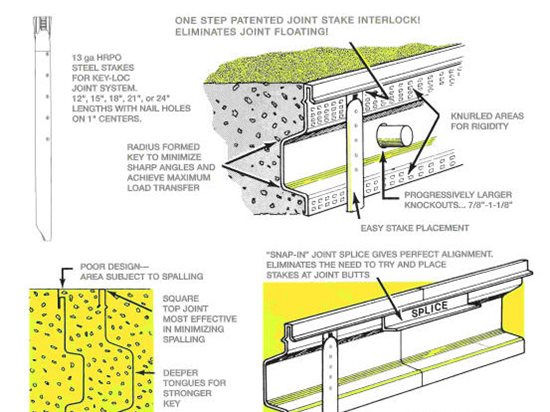- Concrete joints home
- Isolation joints
- Construction joints
- Contraction joints
- Locating & Filling Joints in Concrete Slabs
- Be active in deciding where to place control joints
- Joints in commercial floors
- Sealing joints- Tips for sealing and filling joints
- Related Information:
- How to build high-quality slabs on grade
- Groover tools for forming joints
Construction Joints

Keyed construction joints have been successfully used for many years. Cardinal Manufacturing Company
On many jobs there will be starting and stopping points—you won't pour the entire slab or driveway all at once. That's where you will place a construction joint. Here are a few tips:
- Construction joints are formed using some sort of bulkhead, made of wood, steel, plastic, or precast concrete. These bulkheads are often used as screed rails during placement and finishing of the slab.
- Construction joints should be worked into the overall joint plan, where they can also function as contraction joints.
- A construction joint should also be used in cases of equipment breakdown, an unexpected shortage of materials, or bad weather, although the joint should still be worked into the jointing pattern—placed where a contraction joint was planned. If that's not possible, the odd section may later have to be removed.
- If the slab will have no significant traffic crossing the joint, a plain butt joint, with no reinforcement crossing the joint, is acceptable. If there is to be traffic other than foot traffic, you will need to use some sort of load transfer device.
- For many years, the typical way to transfer shear at a construction joint was with a keyed joint. Many steel bulkhead forms are available with a keyed profile, however most experts no longer recommend keyed joints since they seldom stay tight enough to provide positive shear transfer. ACI 360, Design of Slabs on Ground, states that "the male and female components lose contact when the joint opens due to drying shrinkage," which can lead to "breakdown of the joint edges and failure of the top side portion of the key."
- Use internal vibration during concrete placement at the construction joint to assure proper consolidation along the edge and around any dowels, load transfer devices, or armored joint assemblies—especially if the concrete has larger top-size aggregate.
- Be sure to cure the vertical face after removal of the bulkhead by applying a liquid curing compound.




